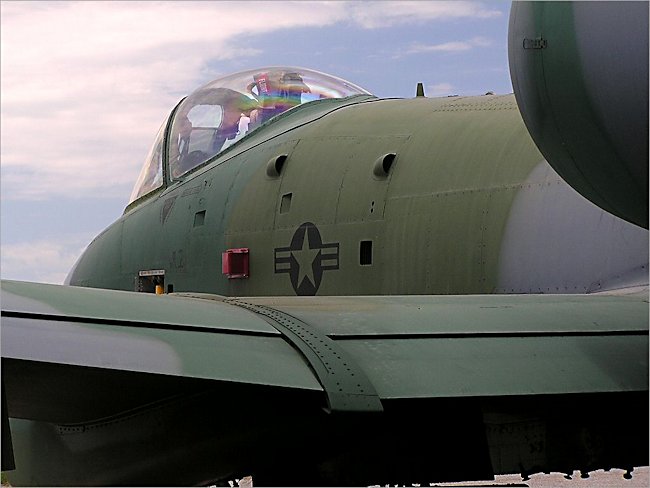USAF A-10 Thunderbolt Warthog
Only 715 Fairchild Republic's A-10 Thunderbolt II tank buster Warthog aircraft were ever produced although the United States Air Force had originally wanted and financed 733. The last A-10 was delivered to Squadron in 1984. Fairchild Republic had dreams of selling around 3,000 aircraft in export orders. This never materialised despite many conflicts around the world and the constant fear of conflict with the Warsaw Pact and their armoured divisions during the cold war.
Fairchild took the A-10 to the 1976 Farnborough Airshow in England and then the 1977 Le Bourget air show in Paris to show it off to potential customers. There was lots of interest but this did not materialise in to firm orders. It did not help that there was a fatal crash at the Paris Air Show. Howard "Sam" Nelson Fairchild Republicís chief test pilot died then his demonstration aircraft tail hit the ground when it failed to pull out of a low level loop manoeuvre. The company still desperate to make sales tried again in 1983 by promoting an upgraded version of the A-10 Thunderbolt with enhanced engines and avionics.

The 333rd Tactical Fighter Training Squadron working out of Myrtle Beach Air Force Base in Arizona were the first unit to get their hands on the A-10 Thundebolt. They were delivered in March 1976. The first Squadron to be designated "combat ready" flying Warthogs was the 354th Tactical Fighter Wing based at the same USAF operational air field. This happened in 1977.USAF A-10 Tactical Fighter Squadrons flew out of a number of Royal Air Force Station in the UK from 1979 onwards. These were RAF Woodbridge, RAF Bentwaters and RAF Alconbury.
It is commonly known the A-10 Thunderbolt was designed to survive over hostile war zones by having large amounts of protective armour. What many do not know is that the designers came up with a clever method of dealing with damage to the landing gear. If the hydraulic systems were damaged and failed due to enemy action the aircraft could still land because the undercarriage is never completely retracted into the bodywork of the plane. The wheels under the wings and nose are always visible when in the retracted position. They work even though they cannot be lowered. This feature has been tested and found to work in real life emergency landing scenarios. The pilot has been able to safely land his Thunderbolt and walk away unhurt with his undercarriage in the up position. This is a very cleaver arrangement.

The life of the A-10 Thunderbolt has been extended by being constantly upgraded. Night vision compatibility, inertial navigation systems, Pave Penny laser receiving pod, LASTE Low Altitude Safety and Targeting systems with computerised weapon aiming, auto pilot and ground collision warning system have all been added. In 1999 a new integrated flight and fire control computer IFFCC system was installed. The ability to carry "smart" munitions, Hotas intergrated targeting pods were introduced in 2005 along with a redesigned cockpit. Newly designed wings will be bolted on to 242 A-10s. The first of these lucky aircraft flew in test trials in November 2011. All this constant work on a forty year old design is hoped to potentially extend its life until 2040.
There was doubt about the relevance of the A-10 Thunderbolt when the Berlin Wall fell in 1989. The threat of thousands of Soviet tanks bulldozing their way across central Europe had now been drastically reduced. Senior Officers in the USAF suggested that the A-10 could be phased out and the close air support role covered by an adapted F-16. Then the problems in the middle east came to the Warthogs rescue. The Thunderbolt was first used in anger after Saddam Hussein's forces invaded Kuwait in 1990. The US sent 194 A-10's to add substance to Operation Desert Storm that launch on 16th January 1991. An unbelievable 8,700 sorties were flown. This worked out at an average of 44 sorties for each aircraft. Most Warthog pilots were in the air for about eight hours a day during the attack. It has been reported that they knocked out around 4,000 artillery pieces, armoured vehicles and tanks. Not bad for an airframe that was until recently considered redundant with no role to play.

Most of Saddam Hussein's air force was either destroyed on the ground by bombing or fled to Iran where it was interned. There were only two air to air combat engagements that resulted in the enemy's aircraft being destroyed. Both of these were by Thunderbolts. Captain Todd Sheehy shot down a Mil Mi-8 helicopter and Captain Robert Swain took out a Bo-105 Helicopter. A-10s are not invulnerable. During the campaign six were shot down by Iraqi Soviet made surface to air missiles SAM. Two pilots lost their lives.

Thunderbolts were used as "peace keepers" in Iraq as part of operation Provide Comfort and Northern Watch, in Bosnia-Herzegovini and the Federal Republic of Yugoslavia. March 2002 saw A-10s based at Bagram Air Force Base in Afghanistan and in Pakistan to take on the Taliban and al-Qaeda fighters. They were involved in a lot of action during Operation Iraqi Freedom. A Scud missile was destroyed by a warthog but another aircraft was shot down. The pilot was able to safely eject. During the civil war in Libya in March 2011, that resulted in the killing of its leader Colonel Gaddafi, A-10 Thunderbolts attacked Libyan military units to protect the rebels and civilians. Here are a few specifications on the A-10 Warthog. It has a service ceiling of 45,000ft (13,700m). Its maximum cruise speed is 439mph (706km/h). 2,580 miles (4,150km) is its ferry range. Its maximum take-off weight is 50,000lbs (23,000kg).